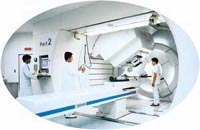Home > About NCCHE > Patient Care
Patient Care
Clinics and Wards
The entrance hall of Hospital East is bright and sunny due to the high and glazed ceiling allowing sunlight to pass into the wide carpeted hall. Upon entering the hall, multiple sections for visitors, such as reservations for examination, admission to the hospital, accounting, pharmacy and so on are arranged in a single line at the reception counter, minimizing as much as possible the distance that patients have to move. Outpatient consultation rooms are located on the first and second floors with a dedicated escalator for exclusive use between floors.Wards in the main building are located on the fourth to eighth floors. Hospitalized patients are generally assigned to an appropriate ward according to the organs to be treated. Each patient can undergo a series of treatments in the same ward regardless of the types of treatment (medical, surgical, and other). Each in-patient ward has ample open space with large windows and the patient names are not indicated at the room front in order to protect their privacy.

Bright entrance hall with many functions

Proton therapy equipment
Diagnosis and Treatment
The Radiology Division is fully equipped with the latest diagnostic tools including four helical CT scanners, two MRI systems, two digital subtraction angiographic (DSA) systems, a positron emission tomography (PET) scanner. All the equipment is digitized allowing radiologists and doctors in change to make accurate and definitive diagnosis and consequently to determine optimal treatment plan of each patient.The Endoscopy Division carries out all endoscopic diagnosis of cancer in the digestive system (pharynx, larynx, bronchus, esophagus, stomach, duodenum, pancreatobiliary tract and large intestine). The Division also conducts endoscopic treatment, particularly endoscopic surgery of early stage tumors of digestive organs. It is established in Japan as an effective non-invasive cancer treatment, which may provide early stage cancer patients with a remission.
The Department of Surgery performs basically function-preserving operations for ordinary cancer patients as much as possible in consideration of patient QOL, but depending on the patient condition and status, the surgery removing organs and their functions is conducted to treat highly progressive cancers in specific organs. Thoracoscopic and laparoscopic surgery are routinely used for the treatment of lung and colonic cancer patients.
Oncology specialists who take active part in medical oncology or hematology perform chemotherapy as a team effort for various malignant patients. Multidisciplinary therapy is initiated for the patients with intractable or refractory cancers in cooperation with oncology radiologists. Bone marrow transplantations as well as peripheral blood stem cell transfusions are carried out to treat hematological malignancies. Multiple clinical trials are ongoing to develop new medicinal standard of care or to advance existing therapies.
Proton Therapy
A proton beam has the nature of being adjustable when applied to the human body due to the emission of total whole energy at a certain depth from the surface of the skin. This nature is utilized for proton therapy, namely, highly concentrated and high-dose proton therapy is available to target the tumor at the greater depth from the skin. The beam can be adjusted on one particular spot resulting in limited radiation damages while ensuring the effectiveness of the treatment. In April 1997, NCCHE became the second hospital in the world to have proton therapy equipment available for patients. After extended investigation and studies, it was finally approved for the treatment of solid tumors at the end of February 2001.
Ward in quiet environment independent of PCU

Service by volunteers
Palliative Care and Volunteer Activities
The Palliative Care Unit (PCU) is attached to the main building, where staff members are devoted to alleviating the distress of terminally ill patients with cancer, such as anxiety, mental disorders, insomnia, breathing difficulty, and cancer pain. This innovative facility is recognized as a model for national hospitals and has been a standard center for other similar facilities in Japan.
Hospital East is supported by the activities of warm-hearted volunteers, who work actively in various areas such as outpatient information center, the mobile library, the palliative care unit, flower arrangement, the gallery, and the flower garden in the back yard of the hospital. Volunteers can be identified by their pink or blue aprons.
